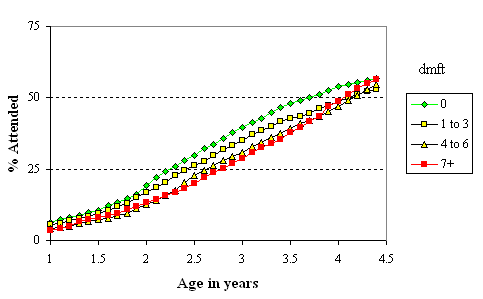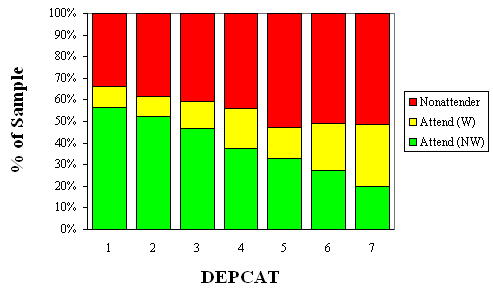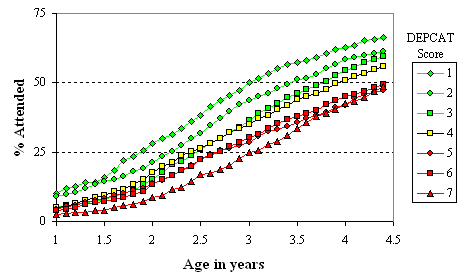Ths peer reviewed article was first published in the journal Tuith OnlineGeneral Dental Service Attendance Patterns of Pre-School Children in Mainland ScotlandIntroduction:The Scottish Health Boards' Dental Epidemiological Programme (SHBDEP) conducts a biennial survey of the dental health of children attending primary one in Scotland, for the National Health Service. The object of this study was to extract information about pre-school dental attendance patterns and examine associations with dental health and deprivation. Materials and Methods:A stratified random sample of children attending the first year of primary school in Scotland (n=7007) was examined for SHBDEP in 1995/96 (Pitts, Nugent and Davies 1996; Pine, Pitts and Nugent 1997). Date of birth, sex, postcode and health board of residence information were recorded. Children born between March 1990 and February 1991 inclusive, for whom sex had been recorded, were selected for the database. These subjects were matched, by health board, sex, date of birth, first six letters of surname, and first four letters of first name, to data held by the Dental Practice Division (DPD) for payment claims made to the National Health Service by General Dental Practitioners (GDP) in Scotland. All claims made after the child was 4 years 6 months old were excluded, as this is the age when the youngest children would be entering school. The data from the DPD contained the date of a course of treatment or registration and whether a weighted entry payment was claimed. Postcoding allowed each child with a complete postcode (n= 5858) to be assigned to a DEPCAT category based on postcode sector of residence (Carstairs and Morris 1991). Results:The original SHBDEP database contained 7007 subjects. However, only 6627 were born within the accepted date range and had sex recorded on the data sheet. Dental treatment is frequently delivered by community dentists in the island health boards (Orkney, Shetland and Western Isles). Relatively few children from these health boards appear in the DPD records (Skipper Plus, 1998) and they have been excluded from the analyses, leaving 6054 subjects included in this study. Subjects can be divided into those who could not be matched with any entries on the database before age 4.5 (non-attenders, 45%), those who attended and for whom at least one dentist received a weighted entry payment (attenders (W), 17%) and those who attended and never had a claim for weighted entry (attenders (NW), 39%). The results of epidemiological examination of each group in the 1995/6 SHBDEP survey, appropriately weighted to correct for differences in sampling intensity in different health boards, are shown in Table 1. Table 1. The results of epidemiological examination of each group in the 1995/96 SHBDEP survey, appropriately weighted to correct for differences in sampling intensity in different health boards.
The age at which the child first attended is illustrated for children with different levels of disease at the SHBDEP survey (Figure 1) The attendance patterns of children from the different DEPCAT areas are described in Figures 2 and 3. Discussion:The methodology of the study involves merging of two data bases compiled for different reasons by different organisations. Problems encountered in this work have been discussed elsewhere (Davies, 1999). Attendance will be underestimated due to subjects moving between health boards, changes of name, and errors in recording. However, the overall attendance figure of 61% between birth and age 4.5 is not seriously at variance with the reported registration rates for Scotland of 65% for 3-5 year olds and 19% for 0-2 year olds in 1996 (Skipper Plus, 1998). Weighted entry pre-school is associated with increases in all aspects of dental disease (Table 1), when this group is compared to both attenders (NW) and non-attenders. These latter may well contain children who would have attended if disease had developed or caused pain. Obviously, some of this group has accessed dental services (hospitals, community dental service, or GDS, but not traceable by this method or after age 4.5) as some have received fillings or extractions. Higher levels of disease are associated with a delay in first appearance at the GDS. However, these differences, most obvious between ages 2 and 3, have disappeared by age 4.5 (Figure 1). Figure 1. Age at first attendance to General Dental Practitioner in National Health Service, by disease level (dmft) when examined at age 5. 
Deprivation has a large and continuing effect on attendance patterns. Frequencies of both non-attendance and attendance (W) increase with increasing DEPCAT (i.e. increased deprivation) (Mantel-Haenszel Test for linear association P < 0.001) (Figure 2). Figure 2. Differences in attendance patterns among DEPCAT categories. W - weighted entry; NW - without weighted entry. 
At age 3 years, half of the children from the least deprived (DEPCAT=1) areas have attended, compared with only 1 in 4 children from the poorest areas (DEPCAT=7). Attendance rates in the poorest areas do not reach 50% by the time the children are 4.5 years old (Figure 3). Figure 3. Age at first attendance to General Dental Practitioner in National Health Service, by DEPCAT. 
Conclusion:The manner of first attendance of children to the GDS is a valuable indicator regarding the subsequent health of their deciduous teeth. Non-attendance and, particularly, weighed entry into the system are associated with higher disease levels. Deprivation is linked to late attendance and weighted entry. Children from the poorest areas in mainland Scotland are less likely to attend, either early or with their dentition in a generally health state. References:Carstairs, V, Morris, R 1991 Deprivation and Health in Scotland. Aberdeen: Aberdeen University Press. Davies, J.A. 1999 Optimising the yield from a series of cross-sectional surveys: an example from Scotland. Community Dental Health "in press". Pine CM, Pitts NB, Nugent ZJ. 1997 British Association for the Study of Community Dentistry (BASCD) guidance on sampling for surveys of child dental health. A BASCD co-ordinated dental epidemiology programme quality standard. Community Dent Health 14 (Supplement 1): 10-17. Pitts NB, Nugent ZJ, Davies JA. 1996 The Scottish Health Boards' Dental Epidemiological Programme Report of the 1995/96 survey of 5 year old children. Dundee: University of Dundee. Skipper Plus Version 4.0 1998 Data for Scotland supplied by the Common Services Agency Practitioner services / Dental Practice Division. Edinburgh. Reviewers:
Written by
Download this article in Adobe pdf format (requires reader available free from Adobe). |
|||||||||||||||||||||||||||||||||||||||||||||||||||||||
|
Web space provided by the University of Dundee,
maintained by
the Dental Health Services Research Unit. Valid XHTML1.0
| |||||||||||||||||||||||||||||||||||||||||||||||||||||||
 |
Evidence-based dentistry web-site | |